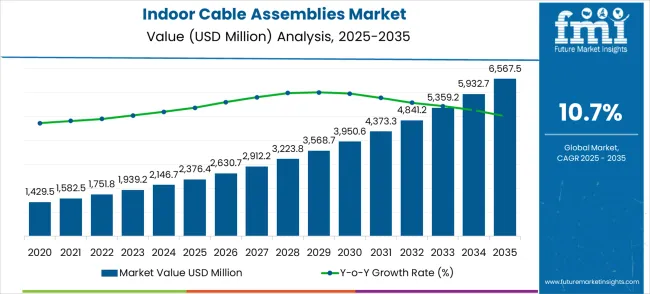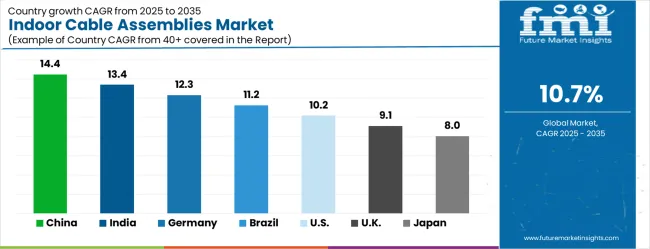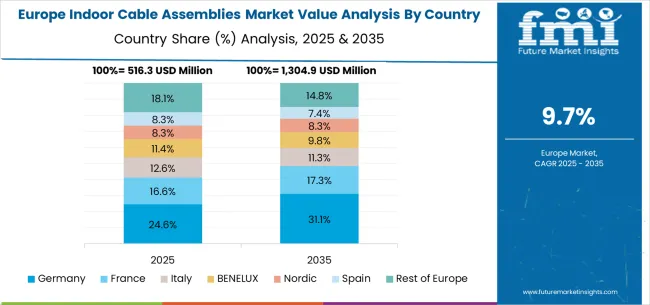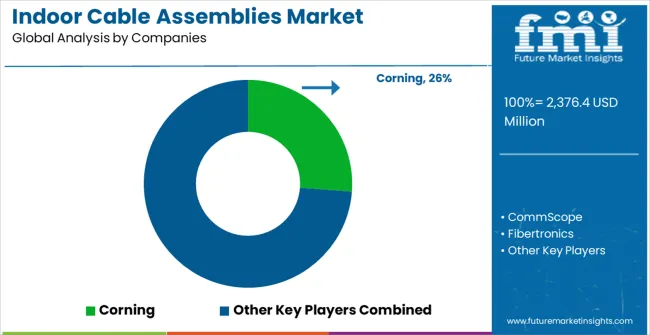The indoor cable assemblies market is projected to grow from USD 2,376.4 million in 2025 to USD 6,567.5 million by 2035, reflecting a forecast CAGR of 10.7%. This growth trajectory emphasizes the increasing demand for structured cabling solutions that support high-speed data transmission, reliable connectivity, and scalable network infrastructure across commercial, industrial, and residential sectors. Rising adoption of smart building systems, enterprise networking, and advanced security installations has reinforced the market’s expansion.
The demand for indoor cable assemblies is expected to be driven by enhanced network performance requirements, standardized installation practices, and the need for flexible, modular cabling solutions that minimize downtime and simplify maintenance. As enterprises and service providers invest in robust IT and communication networks, indoor cable assemblies are positioned as a critical component to ensure operational continuity and improved performance, establishing a consistent upward trend in market value over the forecast period.

Yearly projections indicate that the indoor cable assemblies market will increase steadily, reaching approximately USD 2,638 million in 2026, USD 2,919 million in 2027, and USD 3,218 million in 2028, ultimately achieving USD 6,567.5 million by 2035. The growth pattern demonstrates a sustained adoption of standardized and high-performance cabling solutions, influenced by enterprise expansion, data center upgrades, and the proliferation of connected devices. Factors such as reliability, reduced signal interference, and compatibility with emerging networking protocols are expected to remain key drivers. Incremental deployment across office complexes, healthcare facilities, and commercial buildings is anticipated to boost market value further. The market’s steady growth reflects its integral role in supporting efficient data transmission and resilient communication networks, positioning indoor cable assemblies as indispensable components across sectors where uninterrupted connectivity and network performance are prioritized.
| Indoor Cable Assemblies Market | Value |
|---|---|
| Market Value (2025) | USD 2,376.4 million |
| Market Forecast Value (2035) | USD 6,567.5 million |
| Market Forecast CAGR | 10.7% |
The indoor cable assemblies market holds a notable share within the structured cabling market, contributing around 12% due to its essential role in connecting and organizing communication systems within buildings. In the data center infrastructure market, it accounts for approximately 10%, driven by the demand for reliable internal cabling solutions in high-performance data centers. Within the telecommunications equipment market, the market share is about 8%, reflecting its role in supporting network connectivity and signal integrity. The networking solutions market sees around 7% share, as indoor cable assemblies are integrated into enterprise and commercial networks. Finally, in the electrical wiring and components market, the indoor cable assemblies market holds roughly 5%, highlighting its importance in providing organized, safe, and efficient electrical connections. These combined contributions emphasize the critical role of indoor cable assemblies across multiple connectivity-driven industries.
Market expansion is being supported by the rapid increase in digital infrastructure development worldwide and the corresponding need for high-performance connectivity solutions that provide superior data transmission capabilities and network reliability for advanced telecommunications applications. Modern data centers and enterprise networks rely on consistent high-speed connectivity and signal integrity to ensure optimal data processing performance including cloud computing facilities, enterprise networks, and telecommunications infrastructure. Even minor connectivity inefficiencies can require comprehensive network adjustments to maintain optimal data transmission standards and network performance.
The growing complexity of network infrastructure requirements and increasing demand for high-bandwidth connectivity solutions are driving demand for indoor cable assemblies from certified manufacturers with appropriate performance capabilities and technical expertise. Network operators are increasingly requiring documented performance specifications and reliability standards to maintain data transmission quality and operational efficiency. Industry specifications and performance standards are establishing standardized connectivity procedures that require specialized cable assembly technologies and trained network installation personnel.
The Indoor Cable Assemblies market is entering a new phase of growth, driven by demand for high-speed connectivity, digital infrastructure expansion, and evolving bandwidth and performance standards. By 2035, these pathways together can unlock USD 1,200-1,500 million in incremental revenue opportunities beyond baseline growth.
Pathway A -- High-Density Configuration Leadership (Multifiber Assemblies) The multifiber segment already holds the largest share due to its superior density and scalability. Expanding bandwidth optimization, connector innovation, and installation efficiency can consolidate leadership. Opportunity pool: USD 350-450 million.
Pathway B -- Core Digital Infrastructure (Data Centers & Cloud Computing) Data centers account for the largest demand. Growing cloud computing infrastructure, especially in emerging economies, will drive higher adoption of indoor cable assemblies for connectivity management. Opportunity pool: USD 300-380 million.
Pathway C -- Enterprise Network Expansion (LANs & Campus Networks) Enterprise LANs represent significant growth potential with increasing digitalization. Networks optimized for high-performance enterprise applications can capture substantial growth. Opportunity pool: USD 200-260 million.
Pathway D -- Emerging Market Expansion Asia-Pacific and Latin America present growing demand due to rising digital infrastructure. Targeting telecommunications networks and cost-competitive solutions will accelerate adoption. Opportunity pool: USD 150-200 million.
Pathway E -- 5G & Edge Computing Integration With increasing 5G deployment, there is an opportunity to promote cable assemblies optimized for next-generation network infrastructure. Opportunity pool: USD 100-130 million.
Pathway F -- Specialized Applications (Medical & Industrial) Systems optimized for medical equipment, industrial automation, and specialized applications offer premium positioning for high-performance sectors. Opportunity pool: USD 60-80 million.
Pathway G -- Installation Services & Network Support Recurring revenue from installation services, network maintenance, and infrastructure upgrades creates long-term revenue streams. Opportunity pool: USD 40-60 million.
Pathway H -- Smart Network Integration & IoT Connectivity Digital network monitoring, intelligent connectivity, and IoT integration can elevate cable assemblies into "smart infrastructure" equipment categories. Opportunity pool: USD 30-40 million.
The market is segmented by cable type, application, and region. By cable type, the market is divided into simplex indoor cable assemblies, two fiber indoor cable assemblies, and multifiber indoor cable assemblies. Based on application, the market is categorized into data centers, enterprise LANs, FTTH (Fiber to the Home), medical equipment, and other applications. Regionally, the market is divided into North America, Europe, East Asia, South Asia & Pacific, Latin America, and Middle East & Africa.
In 2025, the multifiber indoor cable assemblies segment is projected to capture around 48% of the total market share, making it the leading cable type category. This dominance is largely driven by the widespread adoption of high-density connectivity solutions that provide optimal balance between space efficiency and bandwidth capability, catering to a wide variety of advanced networking applications. Multifiber cable assemblies are particularly favored for their ability to deliver superior connectivity density and scalability in both data center and enterprise network installations, ensuring network flexibility and future expansion capabilities. Data center facilities, enterprise networks, telecommunications providers, and high-bandwidth applications increasingly prefer this configuration, as it meets demanding connectivity requirements without imposing excessive space constraints or installation complexity.
The availability of well-established manufacturing processes, along with comprehensive technical support options and standardized connector interfaces from leading suppliers, further reinforces the segment's market position. Additionally, this cable type category benefits from consistent demand across regions, as it is considered a practical and scalable solution for facilities requiring high-density fiber optic connections and operational efficiency. The combination of bandwidth capacity, space optimization, and installation flexibility makes multifiber indoor cable assemblies a dependable choice, ensuring their continued popularity in the telecommunications and data center infrastructure markets.

The data centers segment is expected to represent 42% of indoor cable assemblies demand in 2025, highlighting its position as the most significant application sector. This dominance stems from the critical connectivity requirements of modern data center environments, where high-speed data transmission and network reliability are essential to cloud computing performance and digital service delivery. Data centers often feature extensive fiber optic infrastructure that demands specialized cable assemblies throughout complex network architectures, requiring reliable and high-performance connectivity solutions. Indoor cable assemblies are particularly well-suited to these environments due to their ability to provide consistent high-bandwidth performance and signal integrity, even during intensive data processing operations and varying network loads. As cloud computing services expand globally and emphasize improved performance standards, the demand for indoor cable assemblies continues to rise.
The segment also benefits from heightened digital transformation requirements within the technology industry, where operators are increasingly prioritizing network performance and connectivity reliability as essential operational measures. With data centers investing in advanced network infrastructure and 5G-ready connectivity standards, indoor cable assemblies provide an essential component to maintain high-performance digital services. The growth of edge computing and hyperscale data centers, coupled with increased focus on network optimization standards, ensures that data centers will remain the largest and most stable demand driver for indoor cable assemblies in the forecast period.
The Indoor Cable Assemblies market is advancing rapidly due to increasing digital infrastructure development and growing recognition of fiber optic connectivity advantages over traditional copper-based solutions in high-bandwidth applications. However, the market faces challenges including higher initial costs compared to copper alternatives, need for specialized installation and maintenance expertise, and complex compatibility requirements with existing network infrastructure across different technological environments. Performance optimization efforts and advanced connector technology programs continue to influence equipment development and market adoption patterns.
The growing development of advanced fiber optic cables and enhanced connector systems is enabling higher bandwidth capacity with improved signal integrity and reduced transmission losses. Advanced fiber technologies and optimized cable designs provide superior data transmission performance while maintaining installation flexibility requirements. These technologies are particularly valuable for network operators who require reliable connectivity performance that can support extensive data transmission operations with consistent high-speed results.
Modern indoor cable assembly manufacturers are incorporating advanced network monitoring capabilities and intelligent connectivity systems that enhance network performance and operational effectiveness. Integration of smart connector technologies and optimized cable management systems enables superior network optimization and comprehensive infrastructure management capabilities. Advanced network features support operation in diverse digital environments while meeting various performance requirements and connectivity specifications.

| Country | CAGR (2025-2035) |
|---|---|
| China | 14.4% |
| India | 13.4% |
| Germany | 12.3% |
| Brazil | 11.2% |
| United States | 10.2% |
| United Kingdom | 9.1% |
| Japan | 8.0% |
The indoor cable assemblies market is growing rapidly, with China leading at a 14.4% CAGR through 2035, driven by massive digital infrastructure development and increasing adoption of fiber optic connectivity solutions. India follows at 13.4%, supported by rising telecommunications infrastructure development and growing awareness of high-speed connectivity benefits. Germany grows strongly at 12.3%, integrating advanced fiber optic technology into its established telecommunications infrastructure. Brazil records 11.2%, emphasizing digital infrastructure modernization and connectivity upgrade initiatives. The United States shows solid growth at 10.2%, focusing on data center expansion and network optimization. The United Kingdom demonstrates steady progress at 9.1%, maintaining established telecommunications applications. Japan records 8.0% growth, concentrating on technology advancement and network efficiency optimization.
The report covers an in-depth analysis of 40+ countries, the top-performing countries are highlighted below.
The indoor cable assemblies market in China is projected to exhibit the highest growth rate with a CAGR of 14.4% through 2035, driven by unprecedented expansion of digital infrastructure and increasing demand for high-speed fiber optic connectivity solutions. The country's massive telecommunications sector and expanding data center facilities are creating enormous demand for advanced cable assembly solutions. Major telecommunications providers are establishing comprehensive fiber optic networks to support the increasing requirements of digital service companies and data center facilities across metropolitan regions.
Government digital infrastructure development initiatives are supporting establishment of smart city facilities and advanced telecommunications complexes, driving demand for high-performance cable assemblies throughout major technology zones. Telecommunications sector modernization programs are facilitating adoption of fiber optic connectivity technologies that enhance data transmission efficiency and network reliability standards across digital infrastructure networks.
The indoor cable assemblies market in India is expanding at a CAGR of 13.4%, supported by increasing telecommunications sector development and growing awareness of fiber optic connectivity benefits. The country's expanding digital infrastructure and rising network performance standards are driving demand for advanced cable assembly solutions. Telecommunications companies and data center facilities are gradually implementing high-performance connectivity equipment to maintain competitive standards and operational efficiency.
Telecommunications sector growth and digital infrastructure development are creating opportunities for suppliers that can support diverse network requirements and performance specifications. Professional training and technical programs are building expertise among network installation personnel, enabling effective utilization of cable assembly technology that meets telecommunications standards and connectivity requirements.
The indoor cable assemblies market in Germany is projected to grow at a CAGR of 12.3%, supported by the country's emphasis on telecommunications infrastructure quality standards and advanced fiber optic technology adoption. German telecommunications facilities are implementing sophisticated connectivity systems that meet stringent performance requirements and operational specifications. The market is characterized by focus on network reliability, data transmission excellence, and compliance with comprehensive telecommunications standards.
Telecommunications industry investments are prioritizing cutting-edge connectivity technology that demonstrates superior performance and reliability while meeting German quality and efficiency standards. Professional certification programs are ensuring comprehensive technical expertise among network personnel, enabling specialized connectivity capabilities that support diverse telecommunications applications and facility requirements.
The indoor cable assemblies market in Brazil is growing at a CAGR of 11.2%, driven by increasing digital infrastructure development and growing recognition of fiber optic connectivity advantages. The country's expanding telecommunications sector is gradually integrating advanced connectivity solutions to enhance network performance and service quality. Telecommunications facilities and data centers are investing in fiber optic technology to address evolving connectivity requirements and competitive pressures.
Digital infrastructure modernization is facilitating adoption of advanced connectivity technologies that support comprehensive network capabilities across telecommunications regions. Professional development programs are enhancing technical capabilities among network personnel, enabling effective cable assembly utilization that meets evolving telecommunications standards and performance requirements.
The indoor cable assemblies market in the United States is expanding at a CAGR of 10.2%, driven by established telecommunications industries and growing emphasis on network performance enhancement. Large telecommunications companies and data center providers are implementing comprehensive cable assembly capabilities to serve diverse connectivity requirements. The market benefits from established network infrastructure distribution systems and professional development programs that support various telecommunications applications.
Telecommunications industry leadership is enabling standardized connectivity utilization across multiple network types, providing consistent performance standards and comprehensive connectivity coverage throughout regional markets. Professional development and certification programs are building specialized technical expertise among network personnel, enabling effective cable assembly utilization that supports evolving telecommunications facility requirements.
The indoor cable assemblies market in the United Kingdom is projected to grow at a CAGR of 9.1%, supported by established telecommunications sectors and growing emphasis on network performance capabilities. British telecommunications facilities and network service providers are implementing cable assembly systems that meet industry performance standards and operational requirements. The market benefits from established telecommunications infrastructure and comprehensive training programs for technical professionals.
Telecommunications facility investments are prioritizing advanced connectivity solutions that support diverse network applications while maintaining established performance and reliability standards. Professional development programs are building technical expertise among network personnel, enabling specialized cable assembly operation capabilities that meet evolving facility requirements and performance standards.

The indoor cable assemblies market in Japan is growing at a CAGR of 8%, driven by the country's focus on telecommunications technology innovation and network enhancement applications. Japanese telecommunications facilities are implementing advanced cable assembly systems that demonstrate superior performance reliability and operational consistency. The market is characterized by emphasis on technological excellence, quality assurance, and integration with established telecommunications workflows.
Telecommunications technology investments are prioritizing innovative connectivity solutions that combine advanced cable assembly technology with precision engineering while maintaining Japanese quality and reliability standards. Professional development programs are ensuring comprehensive technical expertise among network personnel, enabling specialized connectivity capabilities that support diverse telecommunications applications and facility requirements.

The indoor cable assemblies market in Europe is forecast to expand from USD 620.3 million in 2025 to USD 1,715.9 million by 2035, registering a CAGR of 10.7%. Germany will remain the largest market, holding 30.2% share in 2025, easing to 29.6% by 2035, supported by strong telecommunications infrastructure and advanced fiber optic standards. The United Kingdom follows, rising from 22.4% in 2025 to 22.9% by 2035, driven by telecommunications facility modernization and network enhancement initiatives. France is expected to maintain stability from 17.8% to 17.5%, reflecting consistent telecommunications industry investments and connectivity requirements. Italy holds around 13.1% throughout the forecast period, supported by telecommunications facility upgrades and network infrastructure modernization programs. Spain grows from 9.6% to 10.2% with expanding telecommunications infrastructure and increased focus on fiber optic connectivity solutions. BENELUX markets maintain 4.2% to 4.0%, while the remainder of Europe hovers near 2.7%--2.8%, balancing emerging Eastern European telecommunications development against mature Nordic markets with established fiber optic technology adoption patterns.

The Indoor Cable Assemblies market is defined by competition among specialized fiber optic manufacturers, telecommunications equipment companies, and network connectivity solution providers. Companies are investing in advanced fiber optic technology development, connector innovation, network performance optimization, and comprehensive installation service capabilities to deliver reliable, high-performance, and cost-effective connectivity solutions. Strategic partnerships, technological innovation, and market expansion are central to strengthening product portfolios and market presence.
Corning offers comprehensive fiber optic solutions with established manufacturing expertise and professional-grade connectivity capabilities. CommScope provides specialized telecommunications equipment with focus on network reliability and operational performance. Fibertronics delivers advanced connectivity solutions with emphasis on performance efficiency and network-friendly operation. Fujikura specializes in fiber optic technology with advanced manufacturing integration.
Amphenol offers professional-grade connectivity equipment with comprehensive technical support capabilities. Sumitomo Electric delivers established telecommunications solutions with advanced fiber optic technologies. Fiberdyne Labs provides specialized connectivity equipment with focus on performance optimization. Radiall, Clearfield, ARIA Technologies, Nexconec, Siemon, Belden, L-com, and YOFC offer specialized manufacturing expertise, product reliability, and comprehensive development across global and regional telecommunications market segments.
| Item | Value |
|---|---|
| Quantitative Units | USD 2,376.4 million |
| Cable Type | Simplex Indoor Cable Assemblies, Two Fiber Indoor Cable Assemblies, Multifiber Indoor Cable Assemblies |
| Application | Data Centers, Enterprise LANs, FTTH, Medical Equipment, Other |
| Regions Covered | North America, Europe, East Asia, South Asia & Pacific, Latin America, Middle East & Africa |
| Country Covered | China, India, Germany, Brazil, United States, United Kingdom, Japan, and 40+ countries |
| Key Companies Profiled | Corning, CommScope, Fibertronics, Fujikura, Amphenol, Sumitomo Electric, Fiberdyne Labs, Radiall, Clearfield, ARIA Technologies, Nexconec, Siemon, Belden, L-com, YOFC |
| Additional Attributes | Dollar sales by cable type and application segment, regional demand trends across major markets, competitive landscape with established fiber optic manufacturers and emerging connectivity providers, customer preferences for different cable configurations and performance options, integration with network infrastructure systems and telecommunications protocols, innovations in fiber optic technology and connector efficiency, and adoption of high-density design features with enhanced bandwidth capabilities for improved network workflows. |
The global indoor cable assemblies market is estimated to be valued at USD 2,376.4 million in 2025.
The market size for the indoor cable assemblies market is projected to reach USD 6,567.5 million by 2035.
The indoor cable assemblies market is expected to grow at a 10.7% CAGR between 2025 and 2035.
The key product types in indoor cable assemblies market are simplex indoor cable assemblies, two fiber indoor cable assemblies and multifiber indoor cable assemblies.
In terms of application, data centers segment to command 42.0% share in the indoor cable assemblies market in 2025.






Our Research Products

The "Full Research Suite" delivers actionable market intel, deep dives on markets or technologies, so clients act faster, cut risk, and unlock growth.

The Leaderboard benchmarks and ranks top vendors, classifying them as Established Leaders, Leading Challengers, or Disruptors & Challengers.

Locates where complements amplify value and substitutes erode it, forecasting net impact by horizon

We deliver granular, decision-grade intel: market sizing, 5-year forecasts, pricing, adoption, usage, revenue, and operational KPIs—plus competitor tracking, regulation, and value chains—across 60 countries broadly.

Spot the shifts before they hit your P&L. We track inflection points, adoption curves, pricing moves, and ecosystem plays to show where demand is heading, why it is changing, and what to do next across high-growth markets and disruptive tech

Real-time reads of user behavior. We track shifting priorities, perceptions of today’s and next-gen services, and provider experience, then pace how fast tech moves from trial to adoption, blending buyer, consumer, and channel inputs with social signals (#WhySwitch, #UX).

Partner with our analyst team to build a custom report designed around your business priorities. From analysing market trends to assessing competitors or crafting bespoke datasets, we tailor insights to your needs.
Supplier Intelligence
Discovery & Profiling
Capacity & Footprint
Performance & Risk
Compliance & Governance
Commercial Readiness
Who Supplies Whom
Scorecards & Shortlists
Playbooks & Docs
Category Intelligence
Definition & Scope
Demand & Use Cases
Cost Drivers
Market Structure
Supply Chain Map
Trade & Policy
Operating Norms
Deliverables
Buyer Intelligence
Account Basics
Spend & Scope
Procurement Model
Vendor Requirements
Terms & Policies
Entry Strategy
Pain Points & Triggers
Outputs
Pricing Analysis
Benchmarks
Trends
Should-Cost
Indexation
Landed Cost
Commercial Terms
Deliverables
Brand Analysis
Positioning & Value Prop
Share & Presence
Customer Evidence
Go-to-Market
Digital & Reputation
Compliance & Trust
KPIs & Gaps
Outputs
Full Research Suite comprises of:
Market outlook & trends analysis
Interviews & case studies
Strategic recommendations
Vendor profiles & capabilities analysis
5-year forecasts
8 regions and 60+ country-level data splits
Market segment data splits
12 months of continuous data updates
DELIVERED AS:
PDF EXCEL ONLINE
Indoor Rotary High Voltage Disconnect Switch Market Size and Share Forecast Outlook 2025 to 2035
Indoor Residential Switchgear Market Size and Share Forecast Outlook 2025 to 2035
Indoor Air Quality Monitor Market Size and Share Forecast Outlook 2025 to 2035
Indoor Location Market Size and Share Forecast Outlook 2025 to 2035
Indoor Space Heater Market Size and Share Forecast Outlook 2025 to 2035
Indoor Farming Market Analysis - Size, Share, and Forecast 2025 to 2035
Indoor Smokehouses & Pig Roasters Market – Smoked Meat Processing 2025 to 2035
A Detailed Global Analysis of Brand Share for the Indoor Farming Market
Smart Indoor Gardening System Market Size and Share Forecast Outlook 2025 to 2035
Family/Indoor Entertainment Centres Market Report – Forecast 2017-2027
Medical Indoor Air Purifier Market Size and Share Forecast Outlook 2025 to 2035
Cat Condos & Indoor Houses Market Insights - Size & Trends 2025 to 2035
Cable Line Fault Indicator Market Size and Share Forecast Outlook 2025 to 2035
Cable Tray Market Size and Share Forecast Outlook 2025 to 2035
Cable Granulator Market Size and Share Forecast Outlook 2025 to 2035
Cable Distribution Cabinets Market Size and Share Forecast Outlook 2025 to 2035
Cable Accessories Market Growth - Trends & Forecast 2025 to 2035
Cable Cleaning Solutions Market Analysis - Size, Share, and Forecast Outlook 2025 to 2035
Cable Cleaning Equipment Market Analysis - Size, Share, and Forecast Outlook 2025 to 2035
Cable Material Market Growth - Trends & Forecast 2025 to 2035

Thank you!
You will receive an email from our Business Development Manager. Please be sure to check your SPAM/JUNK folder too.
Chat With
MaRIA